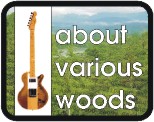
About Various Woods, V0.46; January 20, 2000 (HTML)
file: AVWoods.FAQ.html

About Various Woods, V0.46; January 20, 2000 (HTML)
Compiled by Daniel Cermak-Sassenrath (dace@0rigami.com) from numerous sources.
| I. | Introduction |
| II. | Notes |
| III. | Terminology |
| IV. | Disclaimer |
| V. | Woods |
| VI. | Examples |
| VII. | Web-Sites |
This file represents a try to put together some opinions about different
woods and their properties when used in musical intruments, esp. electric
guitars and basses. I created it for my personal use and didn't care for sources
and authors; I hope I got that right by now, but some are still missing.
When you have information which you think usefull to be included in this file,
please let me know. My email address is dace@0rigami.com.
This is a free file. Its latest version may be obtained through my homepage at
www.0rigami.com/g.
This is designed to print out well, and to act as an off-line hypertext also.
I will not accept responsibility for any information that is contained in this
file. The expressed opinions do not necessarily agree with my own.
All registered trade names and trademarks are the legal property of their
respective holders.
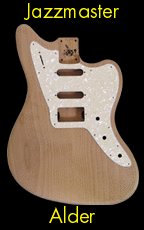
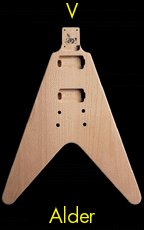
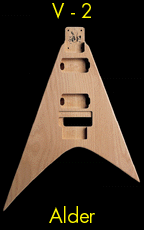
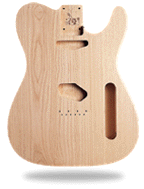
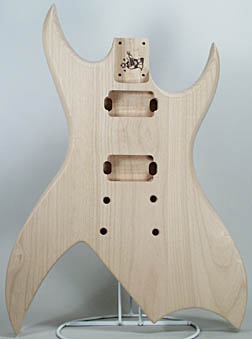
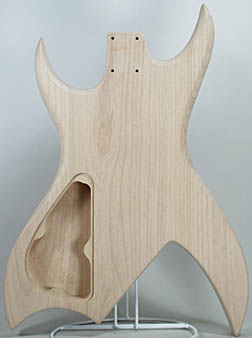
Used [as body material] in several American guitars like the Strat Plus, Clapton, and American Standard. Light weight (body weight about 4 lb.) with a full sound.
Moderate attack and smooth decay yielding an even balanced tone with well defined lows and clear highs. Good choice for guitarists that require the ability to cover a broad range of sounds with one guitar. (ie, Strats) ( Rich Lanser: "The Quest For Ultimate Tone"; Guitar Player magazine; February 1992; quoted acc. to Michael G. Peck (peck@ccu.umanitoba.ca); rec.music.makers.guitar; February 7, 1994)
We get it from the Pacific Northwest. The prices are a little high and the quality is lower today. (exoticwoods.com; 1998)
Alder is used extensively for bodies because of its lighter weight (about four pounds for a Strat body) and its full sound. Its closed grain makes this wood easy to finish. Alder's natural color is a light tan, with little or no distinct grain lines. Alder has been the mainstay for Fender bodies for many years. It looks good with a sunburst and in solid colors. Because of its fine characteristics and lower price, Alder is our most popular wood. [As body material.] (warmoth.com; November 1998)
Rich and full, strong in the lower midrange. This is probably one of the most widely used woods in the 60's for three single coil style guitars. It is medium to light in weight and takes well to sunbursts and some transparent colors. [As body material.] (www.suhrguitars.com; January 2000)
Weight: 35
Grain: straight
Figure: the wood ranges from a light cream to a pale reddish brown with no outstanding figure.
Texture: is smooth and fine
Properties: Alder is a flexible wood and easy to bend. It is stable and will hold its shape. A very good wood for carving and machining. It leaves a clean sharp edge and finishes to a smooth surface. It is an all around easy working wood.
Use: a prime use is for bent structural members and hull planking. Alder would make a nice deck. Well suited for framing and timbering. Nice for turning masts and spars. Suitable for quarter scale and larger carvings. (www.dlumberyard.com; January 2000)
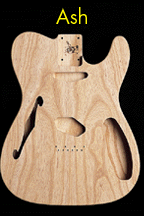
Ash is lightweight and has a good texture. It is particularly good for clear/ transparent finishes. Ash is often used for expensive guitars. (The Guitar Builders FAQ, Part I: Electric Guitars, version 1.4, 10 July 1995)
[Ash body with Quilt Maple top:] Auditioned with a Madagascar Bois de Rose fingerboard. I used to think that the Alder Body/[Maple neck/]Pau Ferro fingerboard was one of the best overdrive tones.... Hmmmm , the Ash Back has that open ring with good clarity. The Maple top seems to add another dimension. Not harsh at all but very alive sounding both clean and dirty. Also an excellent look for transparent colors both on the back and front. Makes for a light guitar as well. I'm getting the itch to build myself one real bad! Nice punch, scooped mids. (www.suhrguitars.com; January 2000)
Ash; Lightweight
It is one of our specialty items. It can be used with a clear finish and has good texture. It is used in a lot of expensive guitars. It grows mostly Southeastern USA. (exoticwoods.com; 1998)
Ash; Northern Hard
This stuff is very hard and heavy. A Strat body will weigh from 5 lbs. and up. With its density, the tone is very bright with a long sustain. Its color is creamy, but also tends to have heartwood of pink to brown tints. The grain is open and takes lots of finish to fill up. Hard Ash is popular for its bright, long sustain. [As body material.] (warmoth.com; November 1998)
Ash; Southern Soft (Ash; Swamp)
Southern Soft or Swamp Ash is a prized wood for many reasons. This is the wood many 50's Fenders were made of. It is easily distinguishable from Northern Ash by weight. A Strat body will be under 5 lbs. This is a very musical wood offering a very nice balance of brightness and warmth with lots of "pop". The grain is open and creamy - a nice choice for clear finishes. Swamp Ash is our second most popular wood. [As body material.] (warmoth.com; November 1998)
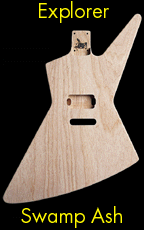
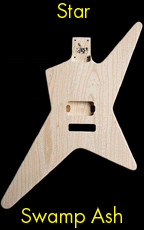
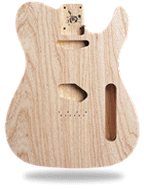
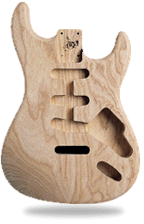
Light weight American wood, has a distinct ringing tone [when used as body material]. This wood works well with spring tremolo systems and single coil pickups to produce a transparent timbre with bell-like overtones. Medium weight bodies yield the best tonal balance and sustain. Extremely light bodies have a weak bottom end and sound thin.( Rich Lanser: "The Quest For Ultimate Tone"; Guitar Player magazine; February 1992; quoted acc. to Michael G. Peck (peck@ccu.umanitoba.ca); rec.music.makers.guitar; February 7, 1994)
The main type used by Fender USA [as body material] is swamp ash because it provides a light weight (body weight about 5 lb.) guitar with a balance of high and low end.
Southern Soft or Swamp Ash is a prized wood for many reasons. This is the wood many 50's Fenders were made of. It is easily distinguishable from Northern Ash by weight. A Strat body will be under 5 lbs. This is a very musical wood offering a very nice balance of brightness and warmth with lots of "pop". The grain is open and creamy - a nice choice for clear finishes. Swamp Ash is our second most popular wood. [As body material.] (warmoth.com; November 1998)
Popular in the 50's for electric guitars this wood is alive and light weight. Swamp ash just wants to vibrate. Bright and sweet at the same time, excellent grain pattern, all transparent finishes look great on Swamp Ash. [As body material.] (www.suhrguitars.com; January 2000)
Several [Fender] Japanese reissue models use Basswood [as body material]. Produces a light (body wt less than 4 lb.) guitar though some people find the sound to be too "dark". Basswood is a very soft wood and cannot handle a lot of abuse (though who among us would abuse our guitars?).
Ideal for loud high gain tones [when used as body material]. The sound is smooth, without many sharp edges. Attack is moderate and sustain is round and even. ( Rich Lanser: "The Quest For Ultimate Tone"; Guitar Player magazine; February 1992; quoted acc. to Michael G. Peck (peck@ccu.umanitoba.ca); rec.music.makers.guitar; February 7, 1994)
For a solid color guitar it is one of the better woods. It is used by many well known large manufacturers. It comes from Northern U.S.A. and Canada. (exoticwoods.com; 1998)
This is a lighter weight wood offering Strat bodies usually under 4 lbs. The color is white, but often has nasty green mineral streaks in it. This is a closed-grain wood, but can absorb a lot of finish. This is not a wood for clear finishes, and it is quite soft, not good for much abuse. Soundwise, Basswood has a nice, warm tone. [As body material.] (warmoth.com; November 1998)
Strong Midrange, balanced tone and light weight. Light color and almost no grain patterns Basswood is best suited for solid colors or is excellent as a backing wood for a maple top. [As body material.] (www.suhrguitars.com; January 2000)
[Basswood body with Quilt Maple top:] Ok, this may be the Holy Grail of tone, The Basswood response is extended by a 3/16" Maple top adding more clearity and grind to the fattness of the Basswood, my favorite! Usually colors chosen will be opaque on the back with transparents on the top, LP style. Excellent with a Maple neck. (www.suhrguitars.com; January 2000)
Weight: 26
Grain: straight
Figure: the wood is a cream color with very little to no pattern from grain.
Texture: a soft wood with a very smooth even texture.
Properties: a top quality wood for carving with a knife. Machining qualities are poor, the wood tends to rip or crush under the pressure of a cutting tool. Basswood is weak and tends to break when cut into small parts. Sawing produces a woolly surface, sands easily. Finishing usually requires a sealer.
Use: the principle use of the wood is cutting lifts for solid hull construction or blocks for carving hulls. The easiness of carving makes Basswood suitable for the joinery work in deck framing. Usable as deck planking and the first layer of planking in plank-on-bulkhead hulls or planked hulls that are going to be painted or glassed over for R.C. models. (www.dlumberyard.com; January 2000)
Laminated Birch consists of 1/32" layers of Birch wood which is bonded with epoxy under high pressure into a composite material. This material is remarkably tough and strong for its weight. It is denser than Birch, but not excessivly heavy. It is extremely stiff, and it's composite nature tends to even out its frequency response, alleviating "dead spots" inherent in single-piece necks. It is dark gray and in color, with alternating dark and light layers. (hembrook.com)
Weight: 47
Grain: generally straight but sometimes found as wavy or curly grain.
Figure: the sapwood is a cream colored tan. The heartwood is a light brown. Slight streaks of a darker color show from grain pattern.
Texture: medium and uniform, slightly on the brittle side.
Properties: an easy wood to work, with hand and power tools. Cuts clean and finishes to a smooth surface. The wood is very tough and flexible, once bent it will hold its shape.
Use: prime use is for framing, hull timbering and bent hull members such as deck clamps. Suitable for planking. The fine carvings on the ships in the Richard Young collection at the Wisconsin Maritime Museum are carved in Birch. (www.dlumberyard.com; January 2000)
Blackwood; African (Grenadilla, Granadillo)
This is the most common wood for the orchestral woodwinds. The tonal quality is bright and stays clear and direct over the flute's full range. (miyazawa.com)
Black with a marble like figure of dark purple and charcoal gray. (www.dlumberyard.com; January 2000)
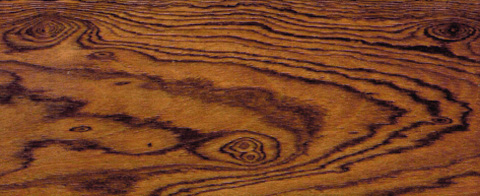
Bocote, from the family Boraginaceae, grows in northern Florida, the West Indies, Central America, and southward to Brazil and Argentina. Bocote is grayish, yellowish or tobacco colored to reddish brown, with irregular dark brown or blackish streaks and variegations, with more or less of an oily or waxy appearance; fine to medium grain. Basic specific gravity > 0.84. Holds its place well when manufactured. A readily worked timber, finishing very smoothly. Durability is rated high. The particular variety we use is yellow with black and dark brown straight streaks. Very hard and dense, it makes excellent fingerboards with a distinctive look. (hembrook.com)
From Central America; Mexico, Guatemala, Honduras, Nicaragua, Colombia, Cuba,
Dominican Republic, Haiti, and Jamaica.
Color ranges from nearly white to golden brown, with irregular reddish to dark
brown streaks. The grain is typically straight, but may vary from straight to
roey. The texture is usually fine to medium, with a somewhat oily or waxy
appearance.
Common uses include cabinetmaking, decorative veneer, fine furniture, interior
trim, balusters, excelsior, floor lamps, moldings, parquet flooring, and
wainscoting.
Specific Gravity is .74 (very dense). Turns easily.
(Woodwriteltd.com; November 1998)
Dark bands of reddish yellow and black. (www.dlumberyard.com; January 2000)
Boxwood has been used for centuries for making woodwind instruments. It has a bright, sweet quality that can also be made rich and colourful by the player. (miyazawa.com)
Weight: 70
Grain: straight
Figure: an even straw yellow color.
Texture: ultra fine and uniform.
Properties: dense and hard. Finishes to a polished surface. Excellent machining properties. The wood will hold a clean sharp edge. Working with hand or carving tools is slow going due to the hardness of the wood.
Use: for all aspects of model work from fine tuned pieces to timbering. A little stiff, but with some care, the wood makes nice looking planking. (www.dlumberyard.com; January 2000)
Boxwood; American (Dogwood)
[no further information available yet]
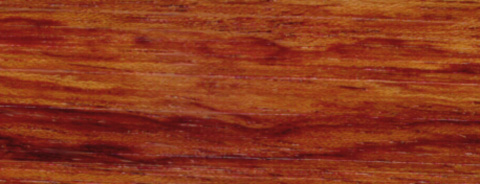
This African import is a very heavy Rosewood, but some customers like it for solid body guitars. (exoticwoods.com; 1998)
Most of the material that begot the perception of quality in the rose wood family is now long gone old growth trees, so perhaps it's time to reevaluate our preferences. By the way, the publics desire for rose woods has also motivated manufactures to fib from time to time. Pau Ferro is not a rose wood, but is easily passed off as one. Bubinga is passed off as Chinese Rose wood even though it is not of the rose wood genus. (Linc Hoke)
A very stiff strong wood with a rusty brown color. Bright midrange and bass tones. [As neck material.] (warmoth.com; January 2000)
From Africa; Gabon, Cameroon, Zaire, Equatorial Guinea, Congo, Liberia and
Nigeria.
Color is medium red-brown, with lighter red to purple veins. The grain is
typically straight. Fine pores are diffused throughout the wood, which often
contain a reddish gum. Texture is usually medium, and surface is highly
lustrous. Excellent polishing qualities.
Common uses included boat building, fine furniture, tool handles, figured
veneer, flooring, and handles.
Specific Gravity is .88 (very dense). Turns well.
(Woodwriteltd.com; November 1998)
Salmon pink with streaks of brown. (www.dlumberyard.com; January 2000)
Yellow to light orange. (www.dlumberyard.com; January 2000)
Cedar; Alaskan (Cedar; Yellow)
Weight: 31
Grain: is always straight
Figure: is an even sulfur color with no distinctive pattern
Texture: fine and uniform
Properties: for a soft wood, Yellow Cedar is quite heavy with a density about the same as Cherry. A very stable wood and it holds it shape with no shrinkage. This wood is exceptionally easy to work, turns well on a lathe, finishes smooth and carves well. Easy to glue. A durable wood resistant to decay.
Use: masting and spars, deck and hull planking, hull timbering and carvings. A good wood where a hand cutting joinery is used. (www.dlumberyard.com; January 2000)
Cedar; Pencil (Cedar; Red)
Weight: 34
Figure: is a cream color or very light yellow.
Texture: is fine and uniform.
Properties: soft and easy to cut and/or machine. Uniform grain in all directions, making it suitable for carving. Takes a very smooth surface from machining. A good wood for gluing.
Use: a good wood for masting, deck and hull planking and also hull timbering. A good wood for solid hulls. Pencil Cedar is in a rapid decline and supply due to the over-lumbering of the tree. (www.dlumberyard.com; January 2000)
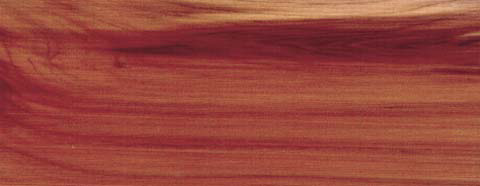
Guitar tops of Red Cedar are the Best Buy today. Material is very fine with good prices in the market. (exoticwoods.com; 1998)
From the United States and Canada.
The color is light reddish brown, purplish or rose-red, usually with streaks of
lighter colored sapwood. Grain is fine and even and texture is usually fine and
takes a high polish. Has a characteristic mild pencil-cedar odor and taste.
Common uses include chests, interior trim, novelties, pencils, posts, wardrobes,
woodenware, fine furniture, foundation posts, moldings and wainscoting.
Specific Gravity is .47 (medium density). Responds well to turning, but some
crumbling is reported.
(Woodwriteltd.com; November 1998)
Cedar; Spanish
Spanish Cedar is the Cedrela species from the Family Meliaceae (same family as
Honduran Mahogany). Cedrela occurs from Mexico to Argentina and is found in all
countries except Chile. Heartwood pinkish- to reddish brown when freshly cut,
becoming red or dark reddish brown, sometimes with a purplish tinge. Grain
usually straight, sometimes interlocked; texture rather fine and uniform to
coarse and uneven; luster medium to high and golden; distinctive cedary odor.
Specific gravity variable ranging from 0.30 to 0.60, averaging about 0.40; Easy
to air-season or kiln-dry, slight warp with little or no checking. Movement in
service rated as small. Spanish Cedar is easy to work with hand and machine
tools and has good gluing properties; stains and finishes well.
Spanish Cedar is favored for millwork, cabinets, fine furniture, cigar wrappers,
and cigar boxes. It is especially popular in boat building, because of its
resistance to rotting. It is used in musical instruments for nylon string
classical and flamenco guitars, because while similar in appearance, strength
and workability to Mahogany, it is considerably lighter. We use it for that
reason on our light weight instruments, weighing about a pound less than a
similar Mahogany bodied instrument. (hembrook.com)
[Chechen:] Used for tops and fingerboards by Modulus; harvested in Mexico. (Seastoner (rfergus@richmond.infi.net); email to Daniel Cermak-Sassenrath; August 9, 1998)
[Chechin:] Marble like figure of shades of reds and maroons. (www.dlumberyard.com; January 2000)

We use mostly Curly Cherry from upstate New York. Curly Cherry is not as curly as Curly Maple. (exoticwoods.com; 1998)
From the United States, Switzerland and Canada.
The popularity of cherry in the furniture market is reported to have increased
over the years because of its warmth, personality, and ease of use. The narrow
sapwood is whitish to reddish brown or creamy pink. The heartwood varies in
color from reddish brown to deep red or light reddish brown, usually with brown
flecks and some gum pockets. Cherry is reported to be very sensitive to UV
light, and changes to its characteristic reddish-brown, mahogany shade upon
exposure. The grain is fine, but material with dark wavy streaks which are
described as striking in appearance are frequently found. Texture is fine and
uniform, and the wood often has narrow brown pith flecks and small gum pockets.
Luster is rich and satiny and finishing characteristics are good.
Common uses include boat building, cabinetmaking, caskets, fine furniture,
musical instruments, scientific instruments, sculpture, figured veneer, interior
construction, handles and wainscoting.
Specific Gravity is .54 (medium density). Turns very easily.
(Woodwriteltd.com; November 1998)
Weight: 35
Grain: straight, also found as curly.
Figure: color is a light red to pink which darkens with age.
Texture: is close, firm and uniform.
Properties: the wood is very stable in use with little to no warpage or movement. Capable of a smooth surface. Works easily with hand and power tools, carves nicely with a clean sharp edge.
Use: a good wood for hull framing and timbering. Suitable for small fittings and hull planking. (www.dlumberyard.com; January 2000)
Cherry; Black
A dark cherry red color. (www.dlumberyard.com; January 2000)
Cherry; Curly (Cherry)
[no further information available yet]
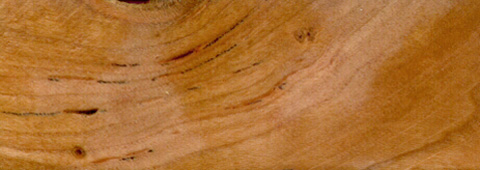
[no further information available yet]

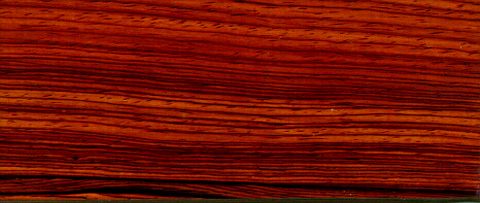
Cocobolo is an attractive, colourful wood with an interesting grain. Due to its lower density it offers a smooth, mellow sound with plenty of warmth. (miyazawa.com)
Cocobolo is an extremely dense (it doesn't float!) hardwood from South
America. The wood has a natural, oily finish. It requires no finish coat of
varnish, shellac or any kind of sealer.
Cocobolo does not soak up water readily, and therefore does not swell when
wet. Nor does it change size appreciably due to variations in temperature.
It's easy to see why the physical properties of Cocobolo make it ideal for
duck and goose call stoppers. Often a call can have a barrel made from other
woods; the stopper is usually Cocobolo on a fine call. Other woods, such
as rosewood, cherry and diamondwood, to name a few, work well as call
stoppers - as do modern synthetics.
Call barrels can be made from anything, plastic or wood - walnut, bois d'
arc, even cedar. It's the stopper that determines the sound of the call.
(quackin.com)
There are roughly a dozen species of true rose woods in the world. (Yes, they smell like roses when cut with a saw.) A partial list would include Tulip wood, King wood, Cocobolo, East Indian Rose wood, and Brazilian Rose wood. With the exception of the latter, these are oily to the point of being dead in the tone department. So what is the point in coveting these materials when there are sonic superiors available? The problem is that in the public mind, rose wood is cool, so it has long been over harvested. Because of this Brazilian Rose wood has been banned from importation to the United States for over twenty five years. (Linc Hoke)
Cocobolo is in the Leguminosae Family and grows mostly in the Pacific regions of
Central America extending from Panama to southwestern Mexico. Of limited
occurrence, usually in the drier uplands. Somewhat variable in color, deep rich
orange-red with black striping or mottling on exposure to air. Fine grain,
straight to interlocked; oily; Basic specific gravity >0.98. Cocobolo is denser
and stronger than Brazilian Rosewood. It has excellent drying properties, free
of surface and end checking. Shrinkage is usually low; high stability in use.
Very low moisture absorption. Cocobolo has excellent machining characteristics;
natural oils give the wood a good polish.
We use Cocobolo for all of our fretless basses because of the extreme durability
and long life of this wood. Its natural hardness and oiliness keep it from
developing the grooves common to other fingerboard woods.
(hembrook.com)
We get it from Mexico and have sold it mostly for Laminate Body Tops. (exoticwoods.com; 1998)
Orange cocobolo is a beautifully colored hardwood, much like ebony, but with a lot of orange, gold, and tones of brown in it. (Bill Zolla (ZOLLAGUITS@aol.com); email to Daniel Cermak-Sassenrath; March 11, 1998)
From Central America: Mexico, Nicaragua, and Panama.
Color varies from orange to deep red with irregular patterns of purple or black. Grain is usually straight and fine
textured. Contains a high oil content, which acts as a barrier to water absorption and imparts a waxy appearance when
rubbed.
Common uses include cabinets, chessmen, inlay work, furniture, cutlery handles, and ornamental work.
Specific Gravity is 1 (very dense). Turns readily to yield smooth surfaces.
(Woodwriteltd.com; November 1998)
Streaks of dark maroon, black, purple and red brown. (www.dlumberyard.com; January 2000)
Cocuswood has always been the elegant one among the various flutemaking woods. A dense, brown wood. It gives a clear, colourful sound. Direct, rich and pure in quality. (miyazawa.com)
Weight: 53
A heavy and dense wood, also known as American Boxwood. A light cream color with a slight pink tint. Takes a super smooth finish. A top notch wood for machining and carving. (www.dlumberyard.com; January 2000)
Ebony, one the heaviest of the hardwoods, is very dense, machines well, and resists warping and cracking. Ebony is a popular wood for fingerboards due to its stability and strength. It holds frets extremely well and has a striking appearance. Ebony is also an expensive choice. (The Guitar Builders FAQ, Part I: Electric Guitars, version 1.4, 10 July 1995)
Maple neck with Ebony veneer gives a "bright" sound and is a very "fast" neck (some people find it "slick" feeling).
The hardest and heaviest; adds snap and clarity to the sound. Crisp attack and open (as opposed to warm) tone. Ideal for players who do a lot of hammer ons and two handed tapping. (as fingerboard material) ( Rich Lanser: "The Quest For Ultimate Tone"; Guitar Player magazine; February 1992; quoted acc. to Michael G. Peck (peck@ccu.umanitoba.ca); rec.music.makers.guitar; February 7, 1994)
Very hard and smooth, fast feeling wood. The color is black, frequently with chocolate brown or dark grey streaks. The tone is very bright. [As neck material.] (warmoth.com; January 2000)
Solid black. (www.dlumberyard.com; January 2000)
[Usage on Fender Strat:] Maple/Ebony neck with the Strat Ultra setup. (as
fingerboard material)
[Usage on Fender Strat:] Maple/Ebony neck with the Floyd Rose Vibrato system.
(as fingerboard material)
Ebony, Macassar
Bands of dark brown and black. (www.dlumberyard.com; January 2000)
Ebony; Texas
Texas Ebony is a member of the Legume family, Pithecellobrium flexicaule. It is
very similar to Mesquite and is closely related. In the Mimosa family, the tree
is shrubby and grows up to 60 feet tall, and three feet in diameter. It is rare,
growing only in southern Texas and northern Mexico. The wood is extremely hard
and dense, and very durable. A dark Chocolate brown to black, with distinct
striping in the grain, it polishes to a mirror shine. It takes frets extremely
well and once dried properly it is extremely stable and won't warp with changes
in humidity. Difficult to work and rare, but its extreme density (sinks in
water), color, polish and stability are everything you could ask for in a
fingerboard.
Limited availability, we sometimes run out of stock on this wood.
(hembrook.com)
Granadillo/Granadilo (Blackwood; African, Grenadilla)
Used for fingerboards by Modulus. (Seastoner (rfergus@richmond.infi.net); email to Daniel Cermak-Sassenrath; August 9, 1998)
Dark chocolate brown with thin streaks of black. (www.dlumberyard.com; January 2000)
Grenadilla (Blackwood; African, Granadillo)
[no further information available yet]
Orange cocobolo is a beautifully colored hardwood, much like ebony, but with a lot of orange, gold, and tones of brown in it. Goncalvo is much the same but more rich browns mixed together. (Bill Zolla (ZOLLAGUITS@aol.com); email to Daniel Cermak-Sassenrath; March 11, 1998)

Very dense smooth texture with a waxy fast feel - no finish required. Color is tan with darker chocolate stripes (used by Smith & Wesson for pistol grips). Articulate clean warm tone. [As neck material.] (warmoth.com; January 2000)
From Central and Latin America; Colombia, Mexico, Venezuela, Bolivia, Brazil,
Ecuador, Paraguay, Costa Rica, Guyana and Peru.
Color is initially reddish-brown, golden-orange or brown-beige to red, usually
richly mottled with dark brown streaks and spots, becoming brown, red, dark
reddish brown with nearly black stripes after prolonged exposure. Grain is
irregular, straight to roey or interlocked. Irregular dark longitudinal bands
produce an attractive figure. Texture is fine to medium. Can be polished and
finished very easily. No grain filling is required and a clear finish has been
suggested to enhance the beauty of the wood.
Common uses include billiard-cue butts, brush backs & handles, figured veneer,
fine furniture, shafts/handles, sporting goods and tool handles.
Specific Gravity is .95 (very dense). Turns easily with sharp tools if straight
grain. Figured pieces require care when turning.
(Woodwriteltd.com; November 1998)
Light and dark brown marble figure. (www.dlumberyard.com; January 2000)
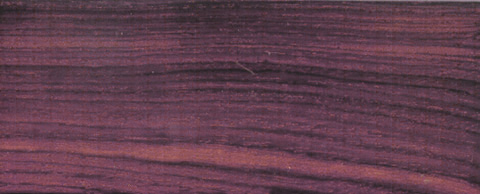
There are roughly a dozen species of true rose woods in the world. (Yes, they smell like roses when cut with a saw.) A partial list would include Tulip wood, King wood, Cocobolo, East Indian Rose wood, and Brazilian Rose wood. With the exception of the latter, these are oily to the point of being dead in the tone department. So what is the point in coveting these materials when there are sonic superiors available? The problem is that in the public mind, rose wood is cool, so it has long been over harvested. Because of this Brazilian Rose wood has been banned from importation to the United States for over twenty five years. (Linc Hoke)
From Brazil.
Color is light golden brown to violet, with irregular black to brown streaks.
The grain is irregular, and a mottled figure similar to that of Rosewood is
sometimes present. The texture is typically fine, and the wood can be polished
and finished very easily.
Common uses included bows, cabinetmaking, carvings, construction, fine
furniture, railroad ties, decorative veneer and wainscoting.
Specific Gravity is .79 (very dense). Turns easily with sharp tools if straight
grain. Figured pieces require care when turning.
(Woodwriteltd.com; November 1998)
Purple with streaks of light and dark violet. (www.dlumberyard.com; January 2000)
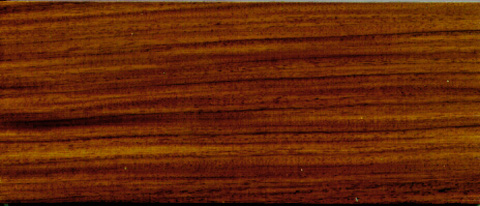
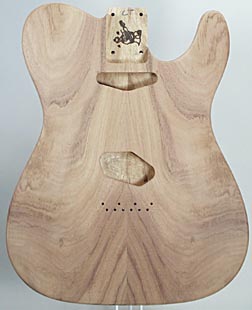
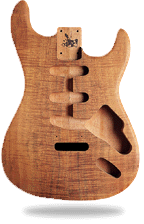
It comes from Hawaii. The good Curly Koa is very hard to get. (exoticwoods.com; 1998)
This very beautiful wood comes exclusively from Hawaii and has been in short supply. Weight varies somewhat from medium to heavy, a good wood for basses. Koa has a warm sound similar to mahogany, but with a little more brightness. Like walnut, this wood may be oiled, but generally will look its best sprayed clear. Koa is sometimes available in flame figure. [As body material.] (warmoth.com; November 1998)
Dark tan to brown with reds and purples. Same weights as mahogany but more beautiful. Warm and solid tone. Sometimes available with flame figure. [As neck material.] (warmoth.com; January 2000)
From Hawaii, it is rare within its natural habitat.
Color varies from tree to tree, ranging from pale yellow or golden brown to deep
chocolate, but more commonly reddish brown with light and dark bands in the
growth rings and various attractive patterns, such as fiddleback and rainbow.
The wavy and curly grain is moderate to severely interlocked. The texture is
moderately coarse, and the surface is quite lustrous and takes a high polish.
Popular for the manufacture of musical instruments because of its high resonant
properties, other common uses include canoes, decorative veneer, gun stocks,
joinery, excelsior, lifeboats, and rifle stock.
Specific Gravity is .67 (dense). Requires sharp tools.
(Woodwriteltd.com; November 1998)
Medium brown wood which looks like Teak. (www.dlumberyard.com; January 2000)
Koa; Curly (Koa)
[no further information available yet]
True name is White Limba, from Africa. Used in Gibson's Explorer and [Flying] V's. A medium weight wood similar to mahogany. Black Limba is usually lighter weight with more interesting grain and darker color. [As body material.] (warmoth.com; November 1998)
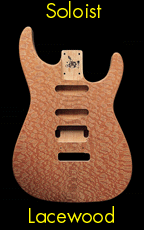
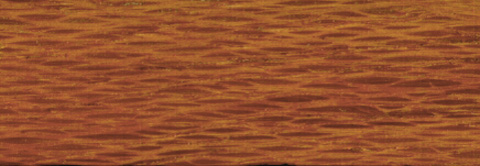
It is a nice wood for Laminate Bodies, with good figure. (exoticwoods.com; 1998)
From Australia: This can be had as a book-matched top, or solid body. The size of the spots range from very small to very large, creating a very striking, reptilian appearance. [As body material.] (warmoth.com; November 1998)
From Australia
Color is pink to reddish brown, and is highly figured with a distinct small
lacelike pattern. The wood is lustrous and has good polishing properties.
Uses include cabinetmaking, fixtures, moldings, parquet flooring, baskets,
casks, drum sticks, fine furniture, organ pipes, pianos, sounding boards,
xylophones.
Specific Gravity is .53 (medium density). Turns easily, but crumbling caused by
the figure is often reported. Care is required to achieve a smooth surface.
(Woodwriteltd.com; November 1998)
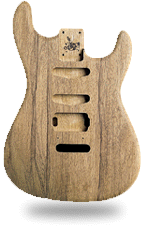
[...] from Africa. [...]. A medium weight wood similar to mahogany. Black Limba is usually lighter weight with more interesting grain and darker color [than Limba; White, Korina]. [As body material.] (warmoth.com; November 1998)
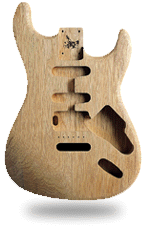
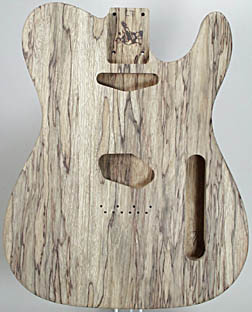
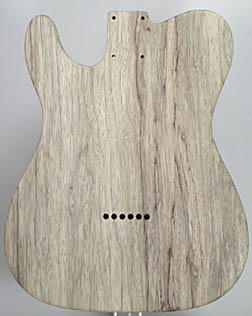
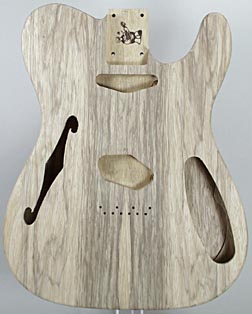
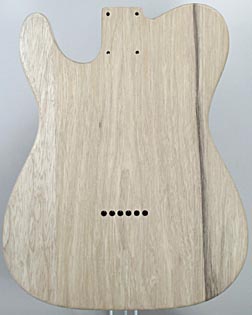
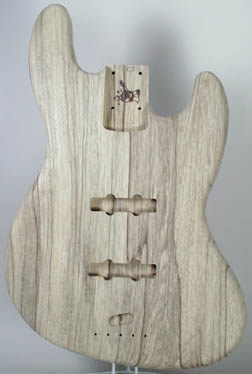
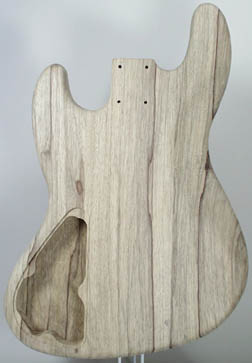
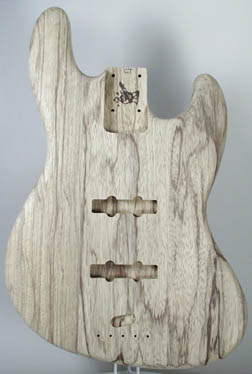
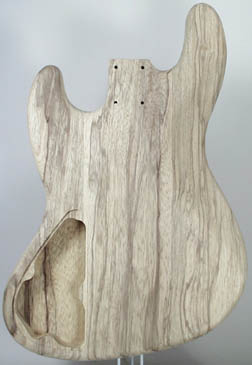
[...] from Africa. Used in Gibson's Explorer and [Flying] V's. A medium weight wood similar to mahogany. Black Limba is usually lighter weight with more interesting grain and darker color. [As body material.] (warmoth.com; November 1998)
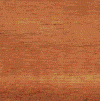
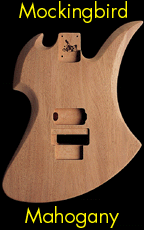
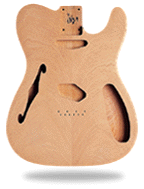
Mahogany is a porous, but strong wood which is easy to machine and finish. It has a spiraling and interlocking grain pattern which makes it a very stable wood. Honduran Mahogany is the favorite choice of instrument builders, but is very hard to find. African and Spanish mahoganies are often used as a replacement for Honduran Mahogany. (The Guitar Builders FAQ, Part I: Electric Guitars, version 1.4, 10 July 1995)
Light to moderately heavy wood with smooth attack and rich singing sustain [when used as body material]. When it's very heavy, the wood losses the warm round attributes. The Gibson Les Paul Standard is a classic example of a mahogony body capped with a maple top. ( Rich Lanser: "The Quest For Ultimate Tone"; Guitar Player magazine; February 1992; quoted acc. to Michael G. Peck (peck@ccu.umanitoba.ca); rec.music.makers.guitar; February 7, 1994)
A warm reddish brown color, lighter in weight than maple with warmer, fatter tone. [As neck material.] (warmoth.com; January 2000)
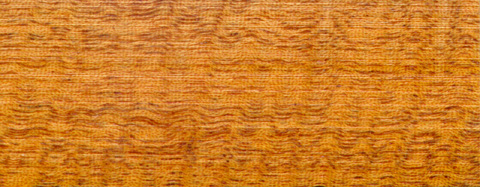
From Africa
Color is yellow to reddish-brown. Grain is interlocked with a stripe or roey
figure. Texture is typically medium to coarse, with a natural luster The timber
is reported to polish to yield and excellent finish. African mahogany is
reported to take stains well.
Uses include boat building, cabinetmaking, decorative veneer, furniture.
Specific Gravity is .44 (medium density). Requires sharp tools.
(Woodwriteltd.com; November 1998)
Mahogany; Honduran
Fender uses the Honduran variety on their set-neck series [as body material]; provides a moderate to heavy weight (body weight at least 5 lb.) with a warm, full sound and good sustain; used in conjunction with a maple top to add brightness.
Swietenia macrophylla, from the Family Meliaceae it grows from Southern Mexico
southward to Colombia, Venezuela, and parts of the upper Amazon and its
tributaries in Peru, Bolivia, and Brazil. Plantations have been established
within its natural range and elsewhere. Honduran Mahogany is reddish, pinkish,
salmon colored, or yellowish when fresh; deepening with age to deep rich red or
brown. Texture rather fine to coarse; grain straight to roey, wavy, or curly,
often with an attractive figure. Basic specific gravity 0.40 to 0.68 averaging
around 0.60. The wood can be air-seasoned and kiln-dried easily without
appreciable warping or checking. Movement after manufacture is rated as small.
Very easy to work with hand and machine tools, Easy to finish and takes an
excellent polish.
Long used in fine furniture and cabinet making, interior trim, paneling, fancy
veneers, boat building, pattern making, turnery, and carving. Often called the
queen of woods because of its working properties. It is the most common timber
used in acoustic guitars for their sides, backs, and necks. Medium weight and
resonant, we use this timber for out body wings. (hembrook.com)
Nice and lightweight, this wood is good for bodies, laminates and necks. (exoticwoods.com; 1998)
We use Honduran Mahogany, the wood LPs are made of. This is a fine wood with good musical properties, the tone is warm and full with good sustain. Weight-wise, mahogany is mid to heavy with a Strat body averaging 5 lbs. or more. The grain is easy to fill although not particularly good looking for clear finishes. [As body material.] (warmoth.com; November 1998)
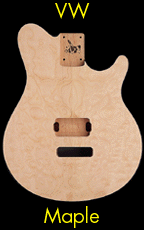
Maple usually comes from 2 sub-families: red maple and sugar maple. The common designation of "curly" and "birds-eye" are natural phenomena of the wood and not a species of their own. Maple is a strong, very heavy wood which is light in color. Maple finishes well and can be steamed and bent. Maple is used in both bodies and necks. If used in necks, it is advisable to laminate the neck from two or three pieces for increased stability. Maple also has very tight pores, a feature which simplifies finishing. (The Guitar Builders FAQ, Part I: Electric Guitars, version 1.4, 10 July 1995)
All maple neck; gives a clear "bright" sound.
Provides a sharp pick attack and quick decay, generating a strong fundamental response without major overtone coloration [when used as body material]. Varieties include; curly, flamed bird's eye, and soft. ( Rich Lanser: "The Quest For Ultimate Tone"; Guitar Player magazine; February 1992; quoted acc. to Michael G. Peck (peck@ccu.umanitoba.ca); rec.music.makers.guitar; February 7, 1994)
Slightly less snap than an Ebony board. More evenly balanced than ebony and the attack and decay characteristics yield sustain and a bright tone. These are mostly one piece necks, ie the fingerboard is the top surface of the neck. (as fingerboard material) ( Rich Lanser: "The Quest For Ultimate Tone"; Guitar Player magazine; February 1992; quoted acc. to Michael G. Peck (peck@ccu.umanitoba.ca); rec.music.makers.guitar; February 7, 1994)
Our Maple necks are 1 piece vintage style with skunk stripe and headstock plug made out of Pau Ferro. We use a very light satin wood feeling finish. Maple has a unique tone, strong in the midrange with a sweet spanky high end. Maple will cut through when you need it and is never muddy on the bass. Good for overdrive, good harmonics. [...] [As neck material.] (www.suhrguitars.com; January 2000)
Weight: 39
Grain: Maple has a wide variety of grain from straight to the exotic like Tiger Maple, birds-eye, fiddleback and a range of twisted and curly.
Figure: all kind of wild patterns can be found from the grain. Straight grained Maple has very little figure. The color of the heartwood is a cream to a light reddish brown. The sapwood is mostly white with a tint of pink.
Texture: very uniform and moderately fine.
Properties: a tough strong wood. Cuts nice and clean, with excellent machining qualities. If too heavy of a cut is taken on a thickness sander the wood will burn. Maple will take a smooth polished surface. Carves sharp and clean with a knife but a little hard to work with using hand tools.
Use: for hull timbering and planking also suitable for small fittings. (www.dlumberyard.com; January 2000)
[Maple neck with Pau Ferro fingerboard:] Quarter sawn Pau Ferro has the good properties of ebony but seems to be more reliable and stable. Pau Ferro is a tight grained hard wood with excellent clarity on the "chunk" tones when using gain, especially when teamed up with an alder body. In overdrive mode it has a fatter low end and more pronounced sparkle when compared to maple. It adds excellent definition to the notes especially when using overdriven tones. Strong in the lower mids and bass, scooped mids. (www.suhrguitars.com; January 2000)
[Maple neck with Indian Rosewood fingerboard:] Sweet and warm, probably one of the most popular fingerboard woods, it is open grained with colors ranging from brown black to red brown. Warm, fat, not too bright, not too dark. Very neutral. (www.suhrguitars.com; January 2000)
[Maple neck with Madagascar Rosewood fingerboard:] Rich color, red brown with interesting patterns to sometimes almost black. Madagascar seems to have a wide frequency response brilliant highs and punchy lows. A tight grained rosewood similar to Brazilian Rosewood. Good with darker sounding body woods and humbucker settings. Strong upper midrange and presence. (www.suhrguitars.com; January 2000)
[Usage on Fender Strat:] Maple/Ebony neck with the Strat Ultra setup. (as
fingerboard material)
[Usage on Fender Strat:] Maple/Ebony neck with the Floyd Rose Vibrato system.
(as fingerboard material)
Maple; Bigleaf (Maple; Soft, Maple; Western Soft)
Western soft maple is another wood like alder that grows all around us here in Washington state. It is usually much lighter than hard maple, but is the same white color. Its sound is characterized by good bite and attack, bright, but not brittle like the harder woods can be. Our fiddleback and quilted bodies are western bigleaf maple. [As body material.] (warmoth.com; November 1998)

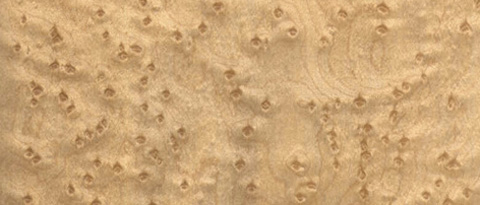
Birdseye Maple is a softer wood [than Cocobolo and Goncalvo] but highly figured. (Bill Zolla (ZOLLAGUITS@aol.com); email to Daniel Cermak-Sassenrath; March 11, 1998)
This is eastern hard maple, available as a book-matched top only. We also do many necks in birdseye. [As body material.] (warmoth.com; November 1998)
This is the same hard maple but with a rare eye-like figure. There is a great deal of variation in figure shape and density. There is no difference in tone or stability from plain hard maple. [As neck material.] (warmoth.com; January 2000)
From the United States and Canada.
The sapwood is white with a reddish tinge. The heartwood color is uniformly
light reddish brown. Grain is straight but occasionally curly or wavy.
Bird's-eye figure is present. Flecks caused by insects may also be present in
the wood. The wood is very fine and even textured.
Common uses include bowling pins, decorative veneer, flooring, lumber, handles,
windows, baskets, casks, drum sticks, figured veneer, fine furniture, cabinets,
organ pipes, pianos , sounding boards, sporting goods, xylophones.
Specific Gravity is .64 (dense). Carbide cutter recommended.
(Woodwriteltd.com; November 1998)
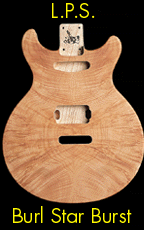
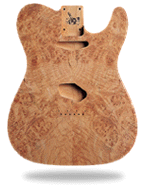
Sometimes this is available as a solid body or book-matched top. Availability is spotty, and it tends to have a lot of holes to fill which makes it more expensive. [As body material.] (warmoth.com; November 1998)

Most of our Curly Maple comes from upstate New York, Michigan and Canada. (exoticwoods.com; 1998)
Curly Maple is a softer wood [than Cocobolo and Goncalvo] but highly figured. (Bill Zolla (ZOLLAGUITS@aol.com); email to Daniel Cermak-Sassenrath; March 11, 1998)
From the United States and Canada.
The sapwood is white with a reddish tinge. The heartwood color is uniformly
light reddish brown. Grain is curly or wavy. The wood is very fine and even
textured. Fibbleback figure is present.
Common uses include bowling pins, decorative veneer, flooring, lumber, handles,
windows, baskets, casks, drum sticks, figured veneer, fine furniture, cabinets,
organ pipes, pianos , sounding boards, sporting goods, violins, [and]
xylophones.
Specific Gravity is .64 (very dense). Good turning characteristics.
(Woodwriteltd.com; November 1998)
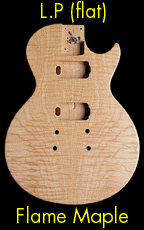
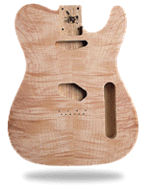
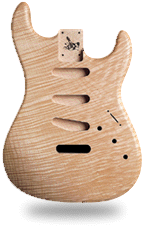
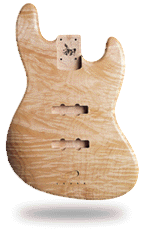
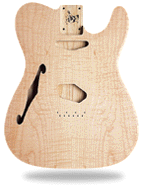
Flamed Maple is a softer wood [than Cocobolo and Goncalvo] but highly figured. (Bill Zolla (ZOLLAGUITS@aol.com); email to Daniel Cermak-Sassenrath; March 11, 1998)
[This wood is] available as book-matched tops on alder, ash or mahogany, or as a solid body. For something truly spectacular, we even have solid 1-piece flame and quilt bodies! (warmoth.com; November 1998)
Maple; German
Not much Maple is left in Germany. The prices for what is available have been going up with every shipment; we have tried to keep the quality up as much as possible. (exoticwoods.com; 1998)
Maple; Hard Rock (Maple; Northern Hard, Maple; Rock, Maple; Sugar)
Hard maple is the same as we use for necks. It is very dense, and weighs like hard ash. The grain is closed and easy to finish. The sound of maple is very bright with long sustain and a lot of bite. Looks good in any style finish. [As body material.] (warmoth.com; November 1998)
The traditional neck wood, creamy white color with a bright clear tone and excellent sustain. [As neck material.] (warmoth.com; January 2000)
Maple; Northern Hard (Maple; Hard Rock, Maple; Rock, Maple; Sugar)
[no further information available yet]
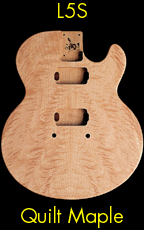
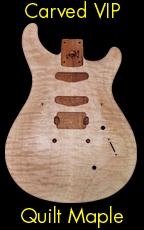
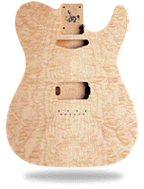
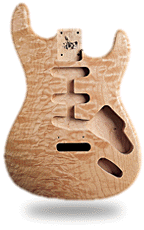
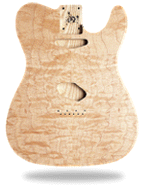
[This wood is] available as book-matched tops on alder, ash or mahogany, or as a solid body. For something truly spectacular, we even have solid 1-piece flame and quilt bodies! (warmoth.com; November 1998)
[Basswood body with Quilt Maple top:] Ok, this may be the Holy Grail of tone, The Basswood response is extended by a 3/16" Maple top adding more clearity and grind to the fattness of the Basswood, my favorite! Usually colors chosen will be opaque on the back with transparents on the top, LP style. Excellent with a Maple neck. (www.suhrguitars.com; January 2000)
[Ash body with Quilt Maple top:] Auditioned with a Madagascar Bois de Rose fingerboard. I used to think that the Alder Body/[Maple neck/]Pau Ferro fingerboard was one of the best overdrive tones.... Hmmmm , the Ash Back has that open ring with good clarity, The Maple top seems to add another dimension, Not harsh at all but very alive sounding both clean and dirty. Also an excellent look for transparent colors both on the back and front. Makes for a light guitar as well. I'm getting the itch to build myself one real bad! Nice punch, scooped mids. (www.suhrguitars.com; January 2000)
Maple; Rock (Maple; Hard Rock, Maple; Northern Hard, Maple; Sugar)
Rock Maple (Acer saccarum, also known as Sugar Maple) is a common hardwood in the Northeastern U.S. It has been the choice for bass necks as long as there has been electric bass guitars. Medium density (Specific Gravity ~.7) very stable and hard. The wood is warp resistant and very smooth. It works extremely well and finishes to a polish. We primarily use choice cuts of straight grained "flamed" Maple which exhibits medulary rays (channels that carry sap across, rather than along the grain). Thus Rock Maple is both lovely and sturdy for use in instrument necks. (hembrook.com)
Maple; Soft (Maple; Bigleaf, Maple; Western Soft)
A little more expensive than Basswood and Poplar, and also a little heavier. (exoticwoods.com; 1998)
Maple; Sugar (Maple; Hard Rock, Maple; Northern Hard, Maple; Rock)
Maple; Western Soft (Maple; Bigleaf, Maple; Soft)
Western soft maple is another wood like alder that grows all around us here in Washington state. It is usually much lighter than hard maple, but is the same white color. Its sound is characterized by good bite and attack, bright, but not brittle like the harder woods can be. Our fiddleback and quilted bodies are western bigleaf maple. [As body material.] (warmoth.com; November 1998)
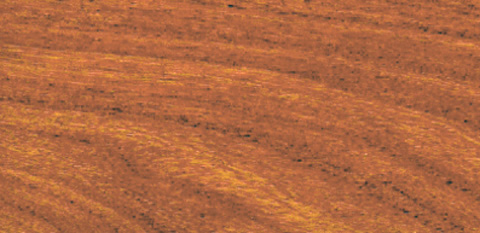
Mesquite is a member of the Legume family, Prosopis Glandulosa, and produces
bean pods yearly. It grows only in four southwestern states in the U.S. and in
Mexico. Mesquite is a heavy wood (Specific Gravity > .8) with a unique quality.
All woods shrink to some degree with changes in their moisture content. Most
woods will shrink more across the grain than along the grain. This can lead to
warpage if the forces are not equal or the grain of the piece is not consistent.
Mesquite shrinks equally in all directions, meaning it is extremely stable and
warp resistant.
We use two types of Mesquite lumber for our instruments:
For neck blanks, we seek out exceptionally straight grained, knot and blemish
free pieces which provide unheard of stability. The difference in density
between Mesquite and Maple means that their resonant frequencies are different,
reducing "dead spots." Dead spots are notes that aren't as loud as others on the
neck because they correspond in frequency to a dip in the frequency response of
the wood of the neck. Using three different species in the neck and fingerboard
increases the likelyhood that where one wood has a dead spot, it will be
compensated for by one or both of the other two species.
For our body tops, we exclusively use burled Mesquite. Some Mesquite trees will
naturally burl, where the grain of the wood is not straight, but twisted and
curled around in crazy patterns. This leads to exceptionally bueatiful woods we
use for the tops on our instruments. Currently we offer crotch grain (v-shaped
grain from the intersection of two limbs) knotty burl (swirled grain from small
limbs and twigs) and Mistletoe burl, (fascinating patterns which are left by the
roots of the parasitic Mistletoe plant as it burrows into the living Mesquite
wood seeking nourishment).
If you have a special request for choice of grain pattern, we will try to fill
it. Mistletoe Burl generally carries an additional charge because of its rarity.
The density of the Mesquite, when applied as a 1/4" top over a core of lighter
Mahogany or Spanish Cedar, adds brightness and attack to the sound of the
instrument to compliment the long, mellow sustain of the body woods. This gives
you a complex combination of tones which is rich in harmonics and attack,
lending a punchy, but still sonorous voice to the guitar. (hembrook.com)
Morado (Pau Ferro, Rosewood; Bolivian)
Oak is heavier than maple and has larger pores. Oak has a desirable grain pattern that makes it a good choice for visual impact. (The Guitar Builders FAQ, Part I: Electric Guitars, version 1.4, 10 July 1995)
Oak; Fishtail
This dark brown wood is heavy, so it is only good for Laminate Tops. (exoticwoods.com; 1998)
Orange to brown color, smooth feeling when played raw. Tone similar to mahogany. [As neck material.] (warmoth.com; January 2000)
Bright orange red. (www.dlumberyard.com; January 2000)
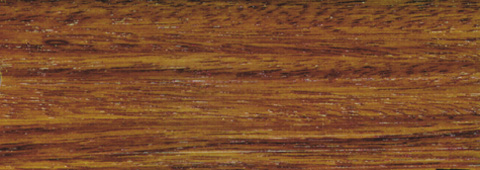
South American Hardwood, combines rosewoods warm tone with Ebony's smooth feel. (as fingerboard material) ( Rich Lanser: "The Quest For Ultimate Tone"; Guitar Player magazine; February 1992; quoted acc. to Michael G. Peck (peck@ccu.umanitoba.ca); rec.music.makers.guitar; February 7, 1994)
Also known as Bolivian Rosewood or Morado. It is heavy, brownish-orange wood with dark black stripes. (exoticwoods.com; 1998)
Most of the material that begot the perception of quality in the rose wood family is now long gone old growth trees, so perhaps it's time to reevaluate our preferences. By the way, the publics desire for rose woods has also motivated manufactures to fib from time to time. Pau Ferro is not a rose wood, but is easily passed off as one. Bubinga is passed off as Chinese Rose wood even though it is not of the rose wood genus. (Linc Hoke)
Primarily available as fingerboards. Medium brown color, very smooth fine grain, warmer tone than ebony. [As neck material.] (warmoth.com; January 2000)
[Maple neck with Pau Ferro fingerboard:] Quarter sawn Pau Ferro has the good properties of ebony but seems to be more reliable and stable. Pau Ferro is a tight grained hard wood with excellent clarity on the "chunk" tones when using gain, especially when teamed up with an alder body. In overdrive mode it has a fatter low end and more pronounced sparkle when compared to maple. It adds excellent definition to the notes especially when using overdriven tones. Strong in the lower mids and bass, scooped mids. (www.suhrguitars.com; January 2000)
From Africa; Congo, Ivory Coast, Zaire, Gabon, Angola, Cameroon, Equatorial
Guine, and Nigeria.
The heartwood is pink, yellow, or dark brown in color and is often striped with
red-brown bands. The grain is usually wavy or interlocked. The wood is rather
coarse-textured. Polishing characteristics are rated as good.
Common uses include carvings, musical instruments, decorative veneer, fine
furniture, and sounding boards.
Specific Gravity is .82 (very dense). Responds well to turning.
(Woodwriteltd.com; November 1998)
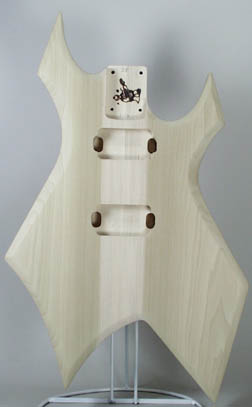
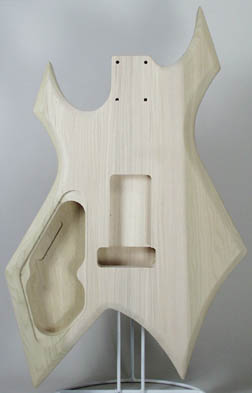
Poplar is similar to Maple in color and weight. The difference is in the size of the pores. (The Guitar Builders FAQ, Part I: Electric Guitars, version 1.4, 10 July 1995)
Don't know too much about this wood. It is probably available in larger quantities than Alder so Fender is using it [as body material] in some guitars.
Same as Basswood, as far as its application is concerned, and in the same price range. (exoticwoods.com; 1998)
This is another standard music wood having been used by many companies over the years. Due to the grey/green color, this wood is used only when solid color finishes are to be applied. It's weight generally runs about half a pound more than alder. Tonally it is much similar to alder as well. Poplar is a closed grain wood that accepts finish well. [As body material.] (warmoth.com; January 2000)
Weight: 30
Grain: straight, sometimes with a slight wave.
Figure: heartwood has a greenish tint, sapwood is an even light yellow with an occasional streak of darker color.
Texture: moderately fine and uniform with a close tough texture.
Properties: easy to work and suitable for carving. Capable of a smooth surface but a non-lustrous finish. Stable and fairly strong.
Use: hull timbering and framing, deck beams and deck framing. (www.dlumberyard.com; January 2000)
Purple colored very dense wood. Bright sounding with a coarser grain, should be finished. [As neck material.] (warmoth.com; January 2000)
An even royal purple. In time, turns to a darker purplish brown. (www.dlumberyard.com; January 2000)
We found a nice stash of highly figured wood, some with wide curl as pictured, and some with a tighter, quilty look. Available as tops, only. [As body material.] (warmoth.com; November 1998)
Rosewood, like ebony, is a popular choice for finger boards. Rosewood, however, is more oily than ebony, making finishing more difficult. Brazilian rosewood is the most sought after type of rosewood and therefore the most expensive. Indian rosewood is often used a replacement for Brazilian rosewood. (The Guitar Builders FAQ, Part I: Electric Guitars, version 1.4, 10 July 1995)
Maple neck with rosewood veneer; gives a "warmer" sound compared to the all maple neck. On some higher ticket Strats, Fender uses Pao Ferro which is a more exotic species of rosewood.
Warmer sounding, with less defined attack than Ebony and Maple (which are both denser woods). Notes seem to bloom,after being picked. Other attributes include a sweet midrange-heavy tone due to it's high oil content. The oil presumably acts as an acoustic damper, rolling of high end. (as fingerboard material) ( Rich Lanser: "The Quest For Ultimate Tone"; Guitar Player magazine; February 1992; quoted acc. to Michael G. Peck (peck@ccu.umanitoba.ca); rec.music.makers.guitar; February 7, 1994)
This is our heaviest wood with Strat bodies always weighing in at over 6 lbs. [...] The sound is warmer than maple. The highs seem to be dampened somewhat by the oily nature of the wood. Finishes can be a little difficult to apply. [As body material.] (warmoth.com; November 1998 and January 2000)
This wood is very stable with a weight about the same as maple. Colors range from very dark purple to browns with shades of yellow and orange. Tonally, it is warmer sounding with balanced sustain. Rosewood requires no finish. [As neck material.] (warmoth.com; January 2000)
Rosewood; Bolivian (Pau Ferro, Morado)
[no further information available yet]
Rosewood; Bois de Rose (Rosewood; Madagascar)
It is the prettiest Rosewood we have ever seen. It is a little more expensive than East Indian, but a lot more rare; we are trying to introduce it to provide more variety of Rosewoods. It grows only in Madagascar. (exoticwoods.com; 1998)
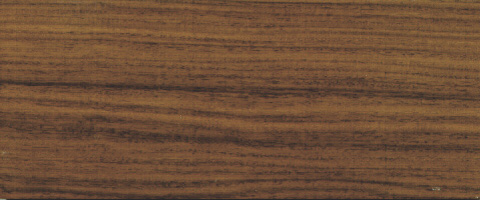
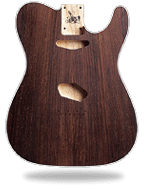
The quality of this wood has gone down over many years and prices have gone up. Very few pieces are instrument grade. Our Brazilian Backs and Sides Sets, even though not up to par with East Indian Sets, are the best available at this time. The quality of bridge blanks and the few fingerboards is good. (exoticwoods.com; 1998)
There are roughly a dozen species of true rose woods in the world. (Yes, they smell like roses when cut with a saw.) A partial list would include Tulip wood, King wood, Cocobolo, East Indian Rose wood, and Brazilian Rose wood. With the exception of the latter, these are oily to the point of being dead in the tone department. So what is the point in coveting these materials when there are sonic superiors available? The problem is that in the public mind, rose wood is cool, so it has long been over harvested. Because of this Brazilian Rose wood has been banned from importation to the United States for over twenty five years. (Linc Hoke)
"Beautiful" wood. There are a wide range of colors and grain. [As body material:] Book-matched tops only. Very limited supply. We also have some necks with Brazilian rosewood fingerboards. (warmoth.com; November 1998)
Available for fingerboards only. Very oily multicolored wood, fast feeling and beautiful. [As neck material.] (warmoth.com; January 2000)
From Brazil.
Varies in color from shades of brown to red or violet, and is irregularly
streaked with black. The grain is typically straight, occasionally wavy.
Texture is medium to coarse and of medium luster.
Common uses include cabinetmaking, fine furniture, marquetry, pianos, tool
handles, drum sticks, organ pipes, sounding boards, umbrella handles,
wainscoting, and xylophones.
Specific Gravity is .85 (very dense). Ease of turning varies from easy to very
difficult. (Woodwriteltd.com; November 1998)
Dark red, violet and black streaks. (www.dlumberyard.com; January 2000)
Rosewood; East Indian (Rosewood; Indian)
It is preferred for musical instruments. It is not the Indonesian Plantation Rosewood, which happens to be the same species, but with different color and much wider grain. (exoticwoods.com; 1998)
There are roughly a dozen species of true rose woods in the world. (Yes, they smell like roses when cut with a saw.) A partial list would include Tulip wood, King wood, Cocobolo, East Indian Rose wood, and Brazilian Rose wood. With the exception of the latter, these are oily to the point of being dead in the tone department. So what is the point in coveting these materials when there are sonic superiors available? The problem is that in the public mind, rose wood is cool, so it has long been over harvested. Because of this Brazilian Rose wood has been banned from importation to the United States for over twenty five years. (Linc Hoke)
PRS uses since c. 1992 East Indian- instead of Braz. Rosewood. (Joy Collins (jcollins@prsguitars.com); email to Daniel Cermak-Sassenrath; July 21, 1998)
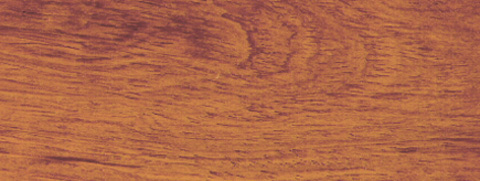
From Belize.
Generally believed to be fairly scarce. Color is pink to purple brown with
darker and lighter bands in attractive combinations. The grain is typically
straight and the texture is medium to fine with a low to medium luster.
Common uses include cabinetmaking, marquetry, tool handles, drum sticks, fine
furniture, handles, organ pipes, piano keys, pianos and xylophones.
Specific Gravity is .96 (very dense). Has excellent turning qualities.
(Woodwriteltd.com; November 1998)
Rosewood; Indian (Rosewood; East Indian)
This is our heaviest wood with Strat bodies always weighing in at over 6 lbs. We've used several different species, depending on availability, but predominantly it is Indian rosewood like the fingerboards. The sound is warmer than maple. The highs seem to be dampened somewhat by the oily nature of the wood. Finishes can be a little difficult to apply. (warmoth.com; November 1998)
[Maple neck with Indian Rosewood fingerboard:] Sweet and warm, probably one of the most popular fingerboard woods, it is open grained with colors ranging from brown black to red brown. Warm, fat, not too bright, not too dark. Very neutral. (www.suhrguitars.com; January 2000)
Rosewood; Indonasian
Deep colors of browns and reds. (www.dlumberyard.com; January 2000)
Rosewood; Madagascar (Rosewood; Bois de Rose)
It appears to be similar to East Indian Rosewood in texture, and color. It is a wood which has not been imported earlier. (exoticwoods.com; 1998)
[Maple neck with Madagascar Rosewood fingerboard:] Rich color, red brown with interesting patterns to sometimes almost black. Madagascar seems to have a wide frequency response brilliant highs and punchy lows. A tight grained rosewood similar to Brazilian Rosewood. Good with darker sounding body woods and humbucker settings. Strong upper midrange and presence. (www.suhrguitars.com; January 2000)
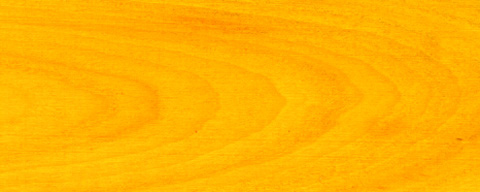
Our Genuine Satinwood is from Sri Lanka. We do not believe that there is any other kind to compete with it. It is of golden color and shiny texture. (exoticwoods.com; 1998)
From Central and Latin America; Guyana, Brazil, Suriname, and French Guiana.
This clearly demarcated sapwood is yellowish white in color. The grain is
straight to slightly interlocked. The wood is fine textured and has good
polishing characteristics.
Common uses include billiard-cue butts, cabinetmaking, carvings, marquetry,
musical instruments, and fine furniture.
Specific Gravity is .69 (dense). Moderately difficult to turn.
(Woodwriteltd.com; November 1998)
Satinwood; Brazilian
Weight: 56
Grain: straight to slightly wavy
Figure: is an even lemon yellow color when freshly cut then darkens to a golden yellow. If the wood is left in the sunlight it will turn to a dark ivory color.
Texture: similar to hard Maple. Heavy, dense and uniform but with a slight coarseness.
Properties: cuts and machines nicely, sands easily and finishes to a smooth satiny surface. The wood is too coarse and hard for carving, it is better suited for power tools rather than hand tools.
Use: decking or decorative planking, cap rails and moldings. Well suited for hull timbering and framing. (www.dlumberyard.com; January 2000)
The problem is the same as with German Maple. (exoticwoods.com; 1998)
Spruce; Sitka
It used to be very easily available, at reasonable prices. This is not the case anymore. (exoticwoods.com; 1998)
Weight: 32
Grain: straight.
Figure: is a creamy white with a pink tint. The grain pattern appears as narrow lines.
Texture: the wood is soft with a moderately fine to medium texture.
Properties: a tough strong wood, stable in use. When cut, the surface tends to be a bit fuzzy, but careful sanding will bring the surface to a smooth finish. The wood works well with both hand and power tools, sands easily.
Use: use for masting and spars. The wood can also be used for heavy timbering, bulkheads, structural members and framing. (www.dlumberyard.com; January 2000)
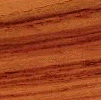

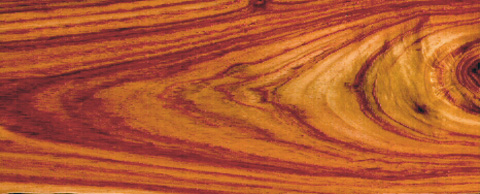
There are roughly a dozen species of true rose woods in the world. (Yes, they smell like roses when cut with a saw.) A partial list would include Tulip wood, King wood, Cocobolo, East Indian Rose wood, and Brazilian Rose wood. With the exception of the latter, these are oily to the point of being dead in the tone department. So what is the point in coveting these materials when there are sonic superiors available? The problem is that in the public mind, rose wood is cool, so it has long been over harvested. Because of this Brazilian Rose wood has been banned from importation to the United States for over twenty five years. (Linc Hoke)
Tulipwood has shades of red, pink, and yellow in it and is hard like ebony. (Bill Zolla (ZOLLAGUITS@aol.com); email to Daniel Cermak-Sassenrath; March 11, 1998)
From Central and Latin America; Brazil, Colombia, Guyana and Venezuela.
Straw colored background with irregular streaks of shades of yellow rose, pink
and violet. Grain is straight to roey, texture is fine, and wood is highly
lustrous with excellent polishing qualities.
Common uses included brush handles, cabinetmaking, flooring, furniture, inlay
work, marquetry, and veneer.
Specific Gravity is .96 (very dense). Requires sharp tools.
(Woodwriteltd.com; November 1998)
Very light cream color with bright thin streaks of pink or sometimes with a few colored streaks. (www.dlumberyard.com; January 2000)
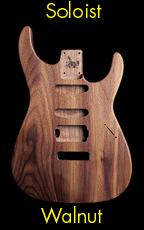

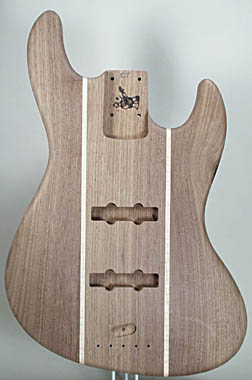
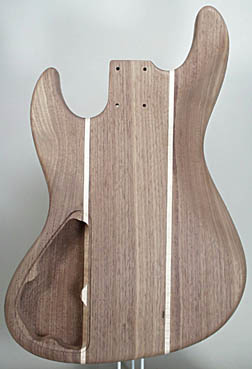
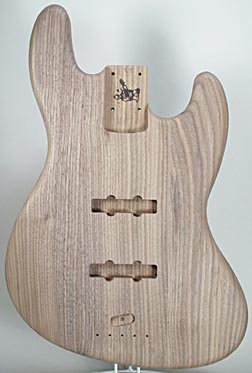
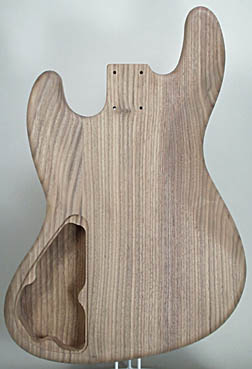
Walnut is a beautiful, rich, brown wood. Walnut is similar to mahogany, but with larger pores and less stability. It is also much more expensive. Walnut has a very appealing grain pattern. (The Guitar Builders FAQ, Part I: Electric Guitars, version 1.4, 10 July 1995)
Walnut is not quite so heavy as hard maple and has a similar sound though not as bright. Walnut is very beautiful with an open grain. Oil finishes can look nice on walnut. [As body material.] (warmoth.com; November 1998)
From the United States and Canada.
The color varies from light grayish brown to deep chocolate brown to an almost
black purplish brown. The appearance of the wood is usually described as warm
and inviting. The grain is slightly open and usually straight, but may be wavy
or irregular. Texture is usually coarse, but uniform. Surface is generally dull,
but is reported to develop a lustrous patina after many years in use. The wood
has excellent finishing characteristics.
Common uses include cabinets, caskets, decorative veneer, fine furniture, gun
stocks, paneling, handles, stencil & chisel blocks and wainscoting.
Specific Gravity is .59 (dense). Turns easily. (Woodwriteltd.com;
November 1998)
Weight: 45
Grain: varies from straight to all kind of wild figures. For model building straight is selected.
Figure: when freshly cut, the wood is purplish-brown turning to a chocolate brown with simple figuring of darker brown streaks. Sapwood is a light tan.
Texture: is uniform and moderately coarse.
Properties: a very nice working wood with power tools right down to a carving knife. Very stable and it will not shrink or expand once in use. For its weight, Walnut is exceptionally strong.
Use: decorative planking, carvings and moldings. Well suited for hull timbering and framing. American Black Walnut is in such high demand on the world lumber markets, and the timber has been so freely exploited, that supply is rapidly diminishing year by year. (www.dlumberyard.com; January 2000)
A black hard wood with chocolate brown stripes. Very hard, coarser textured wood with open grain. Good midrange tone with warm lows. [As neck material.] (warmoth.com; January 2000)
Same as Bubinga in application. It also comes from West and Central Africa. (exoticwoods.com; 1998)
This is another heavy wood with a very open grain. It has a very distinctive look with light and dark brown stripes. It is becoming more difficult to find this wood in thick pieces for bodies, but it is more commonly available for laminated bodies where it excels. Its weight and sound are similar to walnut. [As body material.] (warmoth.com; November 1998)
Fender Tele
maple one-piece bolt-on neck with maple fingerboard, ash or alder body
Fender P-Bass
maple one-piece bolt-on neck with maple fingerboard or maple bolt-on neck with
rosewood fingerboard, ash or alder body
Fender J-Bass
maple one-piece bolt-on neck with maple fingerboard or maple bolt-on neck with
rosewood fingerboard, ash or alder body
Gibson Les Paul Standard
mahogany set-in neck, mohogany body, maple top, rosewood fingerboard
Gibson Les Paul Custom
mahogany set-in neck, mohogany body, maple top, ebony fingerboard
Gibson SG
mahogany set-in neck, mohogany body, rosewood fingerboard
Gibson Flying V
mahogany set-in neck, mohogany body, rosewood or ebony fingerboard
PRS Standard
mahogany set-in neck, mohagany body, rosewood fingerboard
Fender Guitars: guitars/basses
homepage: www.fender.com
email: - (for a conversation of the "that's not my job"-type, try webmaster@fender.com)
Gibson Guitars: guitars/basses
homepage: www.gibson.com
email: relations@gibson.com (customer relations)
Stewart-MacDonald's Guitar Shop Supply: guitar/bass parts and hardware, tools
homepage: www.stewmac.com
email: intl@stewmac.com
PRS Guitars: guitars (and also some basses)
homepage: www.prsguitars.com
email: mquigley@friend.ly.net (customer service)
Rockinger: guitar/bass parts and hardware, tools
homepage: www.rockinger.com
email: info@rockinger.com
Warmoth: guitars/basses custom-made, parts
homepage: www.warmoth.com
email: sales@warmoth.com
WD: guitars/basses custom-made, parts
homepage: www.wdmusicproducts.com
email: wdmusic@mindspring.com